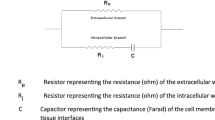Abstract
A Windkessel model has been constructed with the aim of investigating the respiratory-volume dependence of the photoplethysmographic (PPG) signal. Experimental studies show a correlation between respiratory volume and the peak-to-peak value of the respiratory-induced intensity variations (RIIV) in the PPG signal. The model compartments are organised in two closed chambers, representing the thorax and the abdomen, and in a peripheral part not directly influenced by respiration. Cardiac pulse and respiration are created by continuous adjustment of the pressures in the affected compartments. Together with the criteria for heart and venous valves, the model is based on a set of 17 differential equations. These equations are solved for varying thoracic and abdominal pressures corresponding to different respiratory volumes. Furthermore, a sensitivity analysis is performed to evaluate the properties of the model. The PPG signals are created as a combination of peripheral blood flow and pressure. From these signals, the respiratory synchronous parts are extracted and analysed. To study some important limitations of the model, respiratory type and rate are varied. From the simulations, it is possible to verify our earlier experimental results concerning the relationship between respiratory volume and the peak-to-peak value of the RIIV signal. An expected decrease in the amplitude of the respiratory signal with increased respiratory rate is also found, which is due to the lowpass characteristics of the vessel system. Variations in the relationship between thoracic and abdominal respiration also affect the RIIV signal. The simulations explain and verify what has been found previously in experimental studies.
Similar content being viewed by others
References
Barrat-Boyes, G. B., andWood, E. H. (1958): ‘Cardiac output and related measurements and pressure values in the right heart and associated vessels, together with an analysis of the hemodynamic response to the inhalation of high oxygen mixtures in healthy subjects,’J. Lab. Clin. Med.,51, pp. 72–90
Bernardi, L., Radaelli, A., Solda, P. L., Coats, A. J. S., Reeder, M., Calcati, A., Garrard, C. S., andSleight, P. (1996): ‘Autonomic control of skin microvessels: assessment by power spectrum of photoplethysmographic waves’,Clin. Sci.,90, pp. 345–355
Beyar, R., Kishon, Y., Sideman, S., andDinnar, U. (1984a): ‘Computer studies of systematic and regional blood flow mechanisms during cardiopulmonary resuscitation’,Med. Biol. Eng. Comput.,22, pp. 499–506
Beyar, R., Sideman, S., andDinnar, U. (1984b): ‘Cardiac assist by intrathoracic and abdominal pressure variations: a mathematical study’,Med. Biol. Eng. Comput.,22, pp. 507–515.
Beyar, R., andGoldstein, Y. (1987): ‘Model studies of the effects of the thoracic pressure on the circulation’,Ann. Biomed. Eng.,15, pp. 373–383
Brecher, G. A. (1956): ‘Venous return’, (Grune & Stratton. New York)
Challoner, A. V. J. (1979): ‘Photoelectric plethysmography for estimating cutaneous blood flow’,in Rolfe, P. (Ed.), “Non-invasive physiological measurements’ (Academic Press, London) pp. 125–151
Coleman, G. C. (1985): ‘Mathematical analysis of cardiovascular function’,IEEE Trans. BME-32, pp. 289–294
Dinnar, U. (1981): ‘Cardiovascular fluid dynamics’ (CRC Press, Boca Raton)
Dorlas, J. C., andNijboer, J. A. (1985): ‘Photo-electric plethysmography as a monitoring device in anaesthesia’,Br. J. Anaesth.,57, pp. 524–530
Eldrup-Jorgensen, S., Schwartz, S. I., andWallace, J. D. (1966): ‘A method for clinical evaluation of peripheral circulation: Photoelectric hemodensitometry’,Surgery,59, pp.505–513
Grodins, F. S., Buell, J., andBart, A. J. (1967): ‘Mathematical analysis and digital simulation of the respiratory control system’,J. Appl. Phys.,22, pp. 260–276
Hertzman, A. B., andSpealman, C. R. (1937): ‘Photoelectric plethysmography of the fingers and toes in man’,Proc. Soc. Exp. Biol. Med.,37, pp. 529–534
Johansson, A., andÖberg, P. Å. (1998): ‘Estimation of respiratory volumes from the photoplethysmographic signal. Part I: Experimental results’,Med. Biol. Eng. Comput.,37, pp. 42–47.
Lindberg, L-G., Ugnell, H., andÖberg, P. Å. (1992): ‘Monitoring of respiratory and heart rates using a fibre-optic sensor’,Med. Biol. Eng. Comp.,30, pp. 533–537
Mead, J., andWhittenberger, J. L. (1953): ‘Physical properties of human lungs measured during spontaneous respiration’,J. Appl. Phys.,5, pp. 779–796
Moreno, A. H., Burchell, A. R., van der Voude, R., andBlrke, J. H. (1967): ‘Respiratory regulation of splanchnic and systemic venous return,’Am. J. Physiol.,213, pp. 455–465
Nitzan, M., Turivnenko, S., Milston, A., Babchenko, A., andMahler, Y. (1996): ‘Low-frequency variability in the blood volume and in the blood volume pulse measured by photoplethysmography’,J. Biomed. Opt. 1, pp. 223–229.
Noordergraaf, A. (1978): ‘Circulatory system dynamics’ (Academic Press, New York)
Salazar, E., andKnowles, J. H. (1963): ‘An analysis of pressurevolume characteristics of the lungs’,J. Appl. Phys.,19, pp. 97–104
Sheperd, J. T., andVanhoutte, P. M. (1975): ‘Veins and their control’ (W. B. Saunders Company Ltd, London) pp. 134–179, pp. 190–209
Tzelepis, G. E., Nasiff L., McCool, F. D., andHammond, J. (1996): ‘Transmission of pressure within the abdomen’,J. Appl. Phys.,81, pp. 1111–1114
Ugnell, H. (1995): ‘Photoplethysmographic heart and respiratory rate monitoring’, Thesis 386, Department of Biomedical Engineering. Linköping University. Linköing, Sweden
Wade, O. L., andBishop, J. M. (1962): ‘Cardiac output and regional blood flow’ (F. A. Davis Co., Philadelphia)
West, J. B. (1970): ‘Ventilation/blood flow and gas exchange’ (Blackwell, Oxford)
Author information
Authors and Affiliations
Corresponding author
Rights and permissions
About this article
Cite this article
Johansson, A., Öberg, P.Å. Estimation of respiratory volumes from the photoplethysmographic signal. Part 2: a model study. Med. Biol. Eng. Comput. 37, 48–53 (1999). https://doi.org/10.1007/BF02513265
Received:
Accepted:
Issue Date:
DOI: https://doi.org/10.1007/BF02513265




